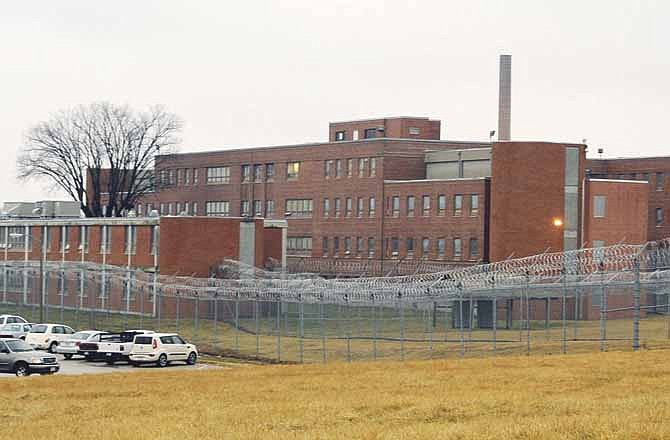FULTON, Mo. - Although Fulton State Hospital has a reputation for being the most dangerous place to work in the state of Missouri, at its heart it is a hospital whose mission is healing people.
On Thursday, a small group of lawmakers toured the facility to learn more about its challenges and shortcomings. The tour was requested by a House committee chair and was attended by Rep. Jeanie Riddle, R-Mokane, a reformer who has been instrumental in advocating for the people who live and work there.
Because the hospital is in her district, Riddle is the first person people call when a problem arises, and sometimes the first to rush to the emergency room when a staffer is injured.
Before Thursday's tour, Riddle discussed her concerns with journalists. "It's the most dangerous place to work in Missouri," she said.
That may be true, but it's still a hospital, not a prison.
The people who live there are called patients, not offenders. They wear street clothes, not uniforms or scrubs. Although their rooms tend to be devoid of all but the most essential personal belongings, their doors are not locked at night. Staff control patients with their hands and their voices, not stun guns or tear gas.
"We offer the same standards of care as any other hospital," said Mark Stringer, director of the Division of Behavioral Health.
The hospital is accredited by The Joint Commission, a nonprofit organization that accredits more than 19,000 U.S. hospitals, health care organizations and programs.
The hospital has four main treatment units: Biggs Forensic Center, a maximum-security facility with 186 beds; Guhleman Forensic Center, an intermediate-security facility with 91 beds; Sex Offender Rehabilitation and Treatment Services, a high-security facility for sexually violent predators with 75 beds; and Hearnes Forensic Center, a minimum-security facility with 24 beds.
But the hospital is managed by the Missouri Department of Mental Health, not the state's Department of Corrections. More civil liberties are permitted. "And we have better food, too," said Ken Lyle, chief financial officer at the hospital.
Of the approximately 333 people who live at Fulton State Hospital, the bulk - 37 percent - are there to be prepared to stand trial. Among the rest, 28 percent are held under civil court detention; 14 percent are considered sexually violent predators; 7 percent have been placed there by a guardian; 5 percent are considered not guilty of committing a crime by reason of insanity; and 5 percent are undergoing pretrial evaluations.
Some patients will spend a few days or weeks at the facility; others likely never will leave.
But, bottom line, Fulton State Hospital is the last stop for people whose behavior can't be controlled safely. It is a place for people who are considered dangerous to others, Stringer said.
Stringer said in the late 1980s, a psychiatric patient in a Kirksville treatment facility beat a seasoned, experienced nurse to death. That patient was sent to Biggs, and now resides in Guhleman. Staff have little control over who arrives, and even less over who leaves.
"There's no place to go beyond Fulton State Hospital," he said.
A dangerous place to work, live
Because the facility is a hospital, the staff rely on their hands and their voices to calm and control patients. That approach has resulted in numerous injuries. Most of the patients are on medication to control the symptoms of their mental illness, but the federal courts have held a person can't be compelled to take drugs, and eight FSH residents do not take psychiatric medications.
"Patient-to-patient violence is notable. But compared with other similar facilities elsewhere, we do better," said Robert Reitz, director of psychiatric facilities. Patient-to-staff injuries pose a significant problem, he said.
Marty Martin-Forman, chief operating officer, said on Wednesday staff dealt with seven incidents of seclusion/ restraint. "We've had 24-hour periods with no incidents," she said.
Tensions tend to rise highest in circumstances where staffers are compelled to lay their hands on a patient. "That's when someone gets hurt," Martin-Forman said. "Incidents from out of the blue are the most dangerous. But our staff is trained to be mindful and prepared."
Statistically speaking, an FSH employee with 30 years of experience can expect to be seriously injured - badly enough to require an emergency room visit - six times.
"Some of these injuries are life-changing," Stringer said.
In fiscal year 2009, the state paid $4 million in workers compensation claims generated by Fulton State Hospital - about half of the state's total worker compensation claims.
In the past two years, administrators have taken steps to employ better practices. "We looked at ways of intervening with people who were getting aggressive. What should you do if you've been bitten? Of if someone grabs your hair? How can you verbally de-escalate a situation? We talked with every major public facility in the country," Reitz said.
The level of danger doesn't always correlate with whether a unit is described as maximum or minimum security. Lyle said the Guhleman Center is experiencing a spate of injuries, primarily caused by one individual whose behavior is mysterious and unpredictable. "Mainly it's caused by one client we can't get a clue on. We are struggling to understand what triggers" this person, Lyle said.
With 1,150 employees, the hospital has a 25 percent annual turnover rate, and vacancy rates exceed 20 percent for psychiatric, nursing and psychologist jobs.
But many workers have stayed with the facilities for decades. "We have generations who have worked here," Martin-Forman said. "This is the largest employer in Callaway County."
It costs between $85 million to $90 million annually to run the hospital, although federal draw-down dollars significantly offset that cost to the state.
Oldest public mental health hospital west of Mississippi
As the oldest public mental health facility west of the Mississippi River, Fulton State Hospital has a long, interesting and sometimes tragic history.
In 1847, the Missouri General Assembly enacted legislation to establish an asylum for the insane in the central area of the state. Several counties were encouraged to bid for the institution; Callaway County was able to produce $11,500 and 500 acres of land, winning the bid.
The decision to open the hospital was prompted by a tragedy. Three years earlier, in the winter of 1844, Missouri Gov. Thomas Reynolds - suffering from "melancholia" and distraught over the "slanders and abuse" of his critics - took his own life in the office of the executive mansion. His successor urged the construction of a state mental hospital in his 1844 message to the Legislature, which helped lead to the opening of the Fulton State Hospital in 1851.
At one point in time, the hospital was nearly a self-sufficient operation with a 2,000-acre farm supporting about 2,000 people.
Another influx of funding came in 1934 when Franklin Delano Roosevelt's New Deal provided several million dollars. The funds were used to build additions, like Biggs and the Dietary Building in 1937.
Although the campus is sprawled over 92 maintained acres, only a few of the 40 buildings are still in use. The rest are ripe for demolition.
"It's a sprawling campus," Stringer said. "No one would build a mental health facility like this today."
"It's not a healthy environment'
Funding for significant new construction hasn't been available for decades, and few observers would argue that facilities aren't crumbling in place around the staff and patients.
Many roofs have leaks; mold is endemic; and stairwells built for fire safety are leaning on their foundations.
"We fight every day to make it fit for living," Martin-Forman said.
On Thursday, staff explained why they feel they desperately need a better facility.
"The quality of the physical plant jeopardizes our accreditation from The Joint Commission," Stringer said. "It's not a healthy environment."
Updating the elderly buildings to eliminate "ligature risks" - or the ability of patients to hang themselves - is an everpresent concern. Sink drains, beds, door handles, hinges and shower curtains - mundane everyday objects - become instruments of death, if not eliminated.
"They always cite us," lamented Reitz.
The hospital's kitchen particularly is antiquated. Some of the equipment still in use was decommissioned from Korean War-era Navy battleships. Replacement parts are no longer available for the kitchen's two large ovens. Without air conditioning on hot summer days, temperatures rise to 106 degrees in the kitchen. Exposed steam pipes pose a danger.
In the Biggs facility, one of the biggest problems is the lack of sound-proofing materials. For safety reasons, nearly every surface is painted or ceramicized concrete block. "It's a typical ward; it echoes in here," said Cheri Maddox, a unit nursing director at Biggs. "Imagine this is your living space."
As the noise increases, so does aggression.
Biggs also is plagued by long hallways, low ceilings and drop ceilings. "Drop ceilings are a great place to hide stuff and sometimes patients grab and drag the metal pieces down and use them as weapons," said Russel DeTrempe, Biggs unit director. "We put staff in impossible situations in this building."
At the top of Stringer's wish list, however, is more space for the patients to perform meaningful work, which he sees as critical for people's well being. Currently, only enough sheltered workshop space is available for patients to work about two hours a day.
"The people who are here do get well, and they do leave to less-restrictive settings," he said. "The tragedy is we have people with serious mental illness, and they want to work. I don't care how ill you are, people want to work. They have to work."
Biggs' dining room also poses significant challenges for staff, because it allows different populations - such as people with developmental disabilities and schizophrenia and people who are high-functioning, but antisocial - to interact.
Stringer said staff aren't looking to expand the Fulton State Hospital with more beds.
"We don't think we need more beds, because we are getting better at treating people with mental illness. But we need better space," Stringer said.
Riddle asked listeners - as they took the tour - to consider this idea: "If you were suffering from a mental illness, do you think you could get better here?"
Bond issue would earmark funds for FSH
Rep. Riddle is hoping the Legislature - possibly via the 5th State Bonding Issue proposed by Rep. Chris Kelly, D-Columbia, or some other funding avenue - can be persuaded to set aside $211 million to improve the campus.
On Feb. 5, the Missouri House Appropriations Committee for Infrastructure and Job Creation held a public hearing to discuss a $950 million bond issue for college buildings and other state construction projects. The legislation is being sponsored by House Speaker Tim Jones.
As envisioned by Riddle, the $211 million would be used to replace the Biggs facility, build a better kitchen and provide a safer environment for staff and a healthier environment for patients.
"I believe this can has been kicked down the road far too long," she said.





